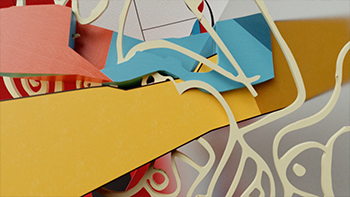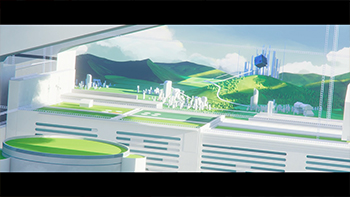ART AFTER DARK 2024
Alex Purcell (United Kingdom)
Alex Purcell is a visual artist with a background in stylish stills and motion. An experienced creative director, motion designer, 3D illustrator, and photographer. He partners with brands to tell stories through captivating visuals. Leveraging design, 3D, live-action and AI, selected clients include Nike, BMW, The New York Times, and Amazon.
Alex Purcell, Creation (still), 2023. Experimental Cinema, Animation: 32 seconds
Creation is a visually immersive, full CGI film that delves into the dynamic evolution of natural elements. Through a series of high-energy macro vignettes inspired by our environment, viewers witness the intricate interplay of texture, light, and shadow as they shape and transform a surreal universe.
Maitry Rao (United Kingdom)
Maitry Rao, born in India and based in London, is a digital artist working in 3D and experimental VR animation. Her Royal College of Art graduation film Anywhere But Here (2021), has been screened at many festivals worldwide, including the London International Animation Festival. She has represented India as a fine artist twice at the International Biennial of Juvenile Art in Portugal where she was awarded a Diploma of Merit Gold on both occasions. She has worked for Shoguns Animation Studio London, The Gazelli Art House and as a freelance Animator. She currently works at Middlesex University London where she supports the 2D and 3D Animation Cohort while continuing to explore 3D and VR Animation as freelance artist.
Matiry Rao, Anywhere but here (still), 2021. Animation: 3 minutes 13 seconds.
Rao’s practice is often characterized by weaving monologue style poems with surreal moving imagery; she incorporates an interactive walking simulator and self-reflexive film as an exploration of autobiographical themes. Anywhere But Here dives into an inner soliloquy as viewers drift through the dreamscape
Anna Katalin Lovrity (Hungary)
Born and raised in Budapest, Anna Katalin Lovrity is an independent animation filmmaker, director, and illustrator. A 2016 graduate of Moholy-Nagy Muvészeti Egyetem (MOME) with an M.A. in Animation, she enjoys experimenting with different techniques and formats. Lovrity premiered her MOME graduation film at Berlinale in 2017, which propelled her professional career at Animation Sans Frontiéres, a European animation production and marketing workshop. Currently, she is developing “Rosie and Sapphire” an animated series for children. Lovrity is the co-author of ZINA, an online zine created by Hungarian female artists. She is also the founder of Rugs by Anna Katalin, an outlet for selling her hand-woven self-designed whimsical rugs. As a freelancer her clients include Telekom Hungary, Telenor, McDonalds, Virag Judit Auctions House, Kolorado Fesztival, and Roche.
Anna Katalin Lovrity, Volcano Island (still), 2019. Animation: 9 minutes, 14 seconds.
“Volcano Island” by Anna Katalin Lovrity follows a young female tiger on a vibrant island with an active volcano, exploring themes of awakening femininity and the dangers of pursuit by a male tiger. The bold, cut-out-inspired animation creates a surreal, tropical environment where the volcano mirrors the tigress’s inner and outer conflicts. Through this striking aesthetic, the film delves into personal growth and the complexities of navigating relationships amidst nature’s powerful forces.
Thisisnotdesign (Canada)
TIND (thisisnotdesign) is a video art collective based in Montreal, Canada, that has been active since 2001. The group, comprising VJs, video artists, and photographers, is known for its groundbreaking approach to live audiovisual creation. Their performances are celebrated for blending analog video errors—compression artifacts, signal interferences, and feedback loops—into layered visual textures that dance between abstraction and figuration. This unique aesthetic mirrors the rhythms of the music they work with, creating a dynamic interplay between sound and image.
thisisnotdesign, Loraine Ipsum (D20+1) (still), 2021. Experimental Cinema, Generative/Algorithmic: 2 minutes, seven seconds.
At the heart of TIND’s work is an embrace of controlled improvisation and real-time experimentation. By hijacking traditional audiovisual equipment, they transform common technical glitches into visually striking elements that evolve with the performance. This artwork exemplifies this approach, offering a fusion of generative visuals and algorithmic sound design that immerses audiences in a constantly shifting audiovisual landscape.
Susi Sie (Germany)
Sie is an Emmy-award-winning artist who works exclusively with analog materials and macro techniques. She creates unique textures with organic movements captured on film and in photography. Sie brings the unseen world to visibility. She endeavors to explore the physical and mathematical elements of form, substance, and material and exposes viewers to the hidden and magical beauty of the natural world. Sie’s unmistakable style has garnered an international reputation and a client roster that includes Netflix, HBO, FX Networks, Olympic Games, Sony, Porsche, and more. Her work has been exhibited around the world and won several awards at international film festivals, and an Emmy in 2023 for outstanding graphic design and art direction for the Netflix documentary “A Trip to Infinity.”
Susi Sie, Chrysopoeia (still), 2023. Experimental Cinema: 1 minute, fifty-one seconds.
This project was directed, produced, and filmed by Berlin-based Susi Sie, with music composed and performed by Nikolai von Sallwitz. The music features live instruments, including cello, bowed strings, piano, guitar, flutes, filtered springs, and wood. The title, Chrysopoeia, derives from Greek and refers to the alchemical process of transmuting base materials into gold. Chrysopoeia is part of von Sallwitz’s Sonic Materia series, which brings together sound and visual art, interpreted by a variety of artists, graphic designers, and motion designers. Like much of Sie’s work, this piece explores the haptic study of genuineness, perception, and authenticity.
Boris Seewald (Germany)
Boris Seewald is an award-winning video director based in Berlin, Germany. Among numerous awards Seewald considers the Cinedans Dioraphte Jury Award and the Promax Award in Gold most noteworthy. He has worked with several artists including Ralf Hildenbeutel, Francesco Tristano, Sebastian Plano, and Alica Sara Ott. Additionally, Seewald has also worked with brands including Adobe, Samsung, Huawei, Microsoft, Daimler, Beyer Dynamic, Photokina, Rosenthal, Ritter Sport, Deutsche Grammophon, Universal Music, Warner Music, Konzerthaus Berlin, Berliner Philharmoniker, and Berlinische Galerie, Arte. Seewald enjoys playing music, seeing movies, and taking photos in his free time. Moreover, he takes great pleasure in sharing his downtime experiences with his daughters.
Boris Seewald, Sway –Video Projection #2 (still), 2024. Projection Mapping and Animation: 1 minute.
By treating video like choreography, Seewald composes imagery rhythmically such that it enhances music and sound in a visual manner. Drawn to the experimental and unconventional, he uses a variety of techniques in his work, combining abstract animation and mixed media with live action footage. The handmade animation style lends his videos the spontaneity and vibrance of a moving painting as seen in the movement that characterizes this work. His films are visually rich, dynamically expressionistic, and peppered with pinches of humor.
Aric Attas (United States)
Aric Attas is inspired by his meditation practice, the study of Kabbalah, and the exploration of scientific cosmology that permeates his work. He says, “I’m curious about the nature of the universe, where we come from and why we’re here. Have you ever looked up on a starry night and felt a sense of wonder, awe, or connection? That’s what inspires me!”
Aric Attas, A Glimpse of Infinity No. 274 (still), 2023. Generative/Algorithmic: 3 minutes, thirteen seconds
Attas seeks to create dynamic experiences where participants are immersed in slowly shifting imagery and sounds that invite an expanded sense of awareness, harmony, and peace. Accompanied by music written by Attas, Glimpse of Infinity draws inspiration from the Big Bang theory, String Theory, gravitational waves, and photographs from the Hubble Space Telescope. He explains, “Following my curiosity has resulted in works that radiate a sense of wonder and connection to the cosmos.”
Camille Scherrer (Switzerland)
Camille Scherrer is a Swiss interaction designer. In 2008, she graduated from École cantonale d’art de Lausanne (ÉCAL) in visual communication, media, and interaction design. Her diploma work was awarded Best European Design and her work has been exhibited and published internationally including the Museum of Modern Art (MoMA) in New York, the annual event for the Special Interest Group on Computer Graphics and Interactive Techniques (SIGGRAPH) in Japan, as well as displays in San Jose, California, and in a digital art festival in Seoul, South Korea. In addition to her art practice, Scherrer is a professor in the media design master program at Haute école d’art et de design (HEAD) in Geneva.
Camille Scherrer, Monumental Tree (still), 2018. Animation: 8 minutes, fifty seconds.
Scherrer creates works at the intersection of technology and art and is always looking for new fields of investigation. Inspired by the mountains where she grew up, animals, cable cars, and old postcards, she manufactures her own universe. Glimpses of these influences can be seen in this animation.
Violetta Pavlovskaia (Russia)
Violetta Pavlovskaia is a concept artist in game development, recognized for her work in animation and digital art. Pavlovskaia’s body of work reflects a deep understanding of movement, rhythm, and the storytelling potential of animation. Her approach is rooted in the joy of discovery, which she translates into her vibrant, kinetic creations. She brings a unique narrative style to her animations, emphasizing playfulness with technical precision.
Violetta Pavlovskaia, POP SHOVE IT, 2019. Animation: nine seconds.
POP SHOVE IT commemorates the joy and fluidity of performing a fundamental skateboarding trick, inspired by personal experiences and nostalgia, even using a fingerboard to help capture the motion and dynamics of the animation. Pavloskaia explained that this is a “simple and beautiful trick” that she was happy to animate, guided by remembered her feelings of performing it.
Eryk Salvaggio (United States)
Eryk Salvaggio is a researcher and new media artist focused on the social and cultural impacts of artificial intelligence. His work examines the creative misuse of AI and the transformation of archives into datasets, aiming to reveal the ideologies embedded in technology and the gaps between datasets and the real world. A hybrid of hacker, researcher, designer, and artist, Salvaggio’s work has been published in academic journals, presented at festivals, and contributed to national tech policy. He holds MSc degrees in Media and Communications from the London School of Economics and Applied Cybernetics from the Australian National University.
Eryk Salvaggio, Moth Glitch (still), 2024. Experimental Cinema, Generative/Algorithmic: 2 minutes, forty-three seconds.
With music composed by Salvaggio himself, Moth Glitch pays homage to Stan Brakhage’s groundbreaking 1963 film, Mothlight and cybernetic computer art. An innovative moment in experimental cinema, Brakhage attempts to fuse the world of images and physical reality into the same space through AI generated images of moths and sound. Salvaggio superimposes AI-generated moth videos and images collected by triggering AI models to fail. The film celebrates the whimsical flighted creatures inside AI by pairing them with AI-generated Gaussian feedback loops (in probability theory, a Gaussian process involves the collection of random variables indexed by time or space). In video generation models, these malfunctions result in colorful swirls of noise.
dNASAb (United States)
[dNASAb] is a Brooklyn, NY based innovative sculptor of ecosystems. By infusing discarded materials and consumer electronics with the wisdom of natural symbiotic networks, [dNASAb] pioneers interactive narratives through extended realities, augmented sculptures, and web3 initiatives while harnessing artificial intelligence models to intervene collaboratively in real-life environmental challenges. [dNASAb] has a BFA in Sculpture/Mixed Media from Florida State University. Additionally, as a 2006 participant in the International Summer Residency at the Experimental Television Center in Owego, NY, he worked with the “Wobulator,” Nam Jun Paik’s pioneering video synthesizer. In 2010, he was awarded a scholarship at Harvestworks Digital Media Arts Center in New York, among many other accolades. His work has been published in the Washington Post, Sculpture magazine, and Art Papers among others.
[dNASAb], Faux Ecologies + Augmented Visions of Nature (still), 2024. Experimental Cinema, Generative/algorithmic: 4 minutes, forty-three seconds.
In merging art and technology, the artist addresses prevailing notions of loss, decay, planned obsolescence, e-waste, and environmental degradation. [dNASAb] explains, “like an ocean gyre, a vortex of artifacts of a consumption-based contemporary society such as plastic bottles and bags, fishing nets, and helium balloons become ensnarled with driftwood, dead coral, and seaweed creating a grotesques amalgamation of disparate materials which remarkably can still harbor life and be a sculptural framework for life to grow. I aim to develop work that embodies this contemporary conundrum.”
Dev Harlan (United States)
Dev Harlan is a New York based artist working in sculpture, installation, and digital media. His work has been exhibited in the U.S. and internationally and commissioned by corporate and private collectors. A 2020 NYFA Fellowship Finalist in Digital Media Arts, Harlan was also the 2022 recipient of the Mozaik Artist Grant. His artwork has been exhibited at Christopher Henry Gallery and Gallery Madison Park, both in New York City. Group shows have included “Noor” at the Sharjah Art Museum in the United Arab Emirates and the Singapore Light Art Festival, among others. Harlan has been an artist in residence at the Frank Lloyd Wright School of Architecture, and currently he is pursuing a B.A. in Earth Science at Columbia University.
Dev Harlan, Afterlives II (still), 2023. Animation and Generative/Algorithmic: 2 minutes, forty-nine seconds.
Afterlives II is part of a series of digital animations which reflect on the themes of global resource extraction and the myth of limitless consumption. The work depicts speculative 3D renderings of metals, minerals, mobile devices and e-waste using photogrammetry scans of real found objects such as natural stone or discarded e-waste. By juxtaposing the fantastic and the mundane, the work invites reflections and critique on the way natural resources are consumed to satiate desire in the digital economy.
Bora Rex (United States)
Interdisciplinary artist and writer Bora Rex makes works with paint, wood, celluloid, and words. He is the founder and editor of These Accents—an online scrapbook for artists of all disciplines to share work they feel contributes to a discussion of the incomplete, in-progress, or otherwise unfinished. Recently, he exhibited in a 2024 group show at Schoenberg Art Walk in the University of California Los Angeles Herb Alpert School of Music; his work has also been exhibited at Regent’s Park College in Oxford, UK and in the 2019 Transitus Show at Lund Gallery in London.
Bora Rex, Quiet Street Noisy (still), 2023. Experimental Cinema, Generative/Algorithmic: 2 minutes, forty-nine seconds.
Utilizing software developed by the University of Oslo to convert video pixel-values into sound frequencies, Quiet Street Noisy is a noisy film about a quiet suburban street. Additional field recordings in Quiet Street Noisy were collected by Rachel Bain.
David Bennett (United States)
David Bennett is a digital artist, motion designer, and creative director, whose work is process oriented and centered on the moving image. Drawn to immediacy and impermanence, he explores saturated, hyper-frequency visuals that oscillate between abstract and figurative digitized glimpses of daily life and random ephemera. The work is often deconstructed and remixed for new iterations. It combines planned patterns, colors, and rhythms with chance, generative, and procedural methods, sometimes using machine learning or AI. Music and sound inspire his rhythmic and sequencing choices. He lives and works in Nashville, Tennessee. Bennett has recently exhibited at Generative Art Project (Austin, TX), Supernova (Denver, CO), Frist Art Museum (Nashville, TN), Punto y Raya (Wroclaw, Poland), and The GIFer: International GIF Art Festival (Turin, Italy).
David Bennett, Radiation (still), 2023. Experimental Cinema, Animation, Generative/Algorithmic, Hybrid: animation, video, audio synthesis, generative text-to-image AI: 1 minute, twenty-three seconds.
While artificial flowers commemorate the moment of sea change in this generation, Radiation serves to commemorate a moment forever altered in art making—the end of one era and the beginning of another. The central “artificial” flowers were created with text to image generative AI. The motion is recursive video feedback style animation achieved with After Effects while the audio is created with a series of hardware synthesizers captured and mixed with Audition and Ableton Live.
GRAPHSET (France)
Mikkael Doczekalski lives in Paris and has worked under the pseudonym Graphset since 2007. He exhibits an extended range of graphic design from printed objects to motion design and stage design. His productions are the result of an atypical academic and professional background. Trained initially in automation techniques Doczekalski started his career in industrial robotics. He developed a special graphical logic and method that he blended into his creative works at the École Nationale Superieur d’Art de Paris/Cergy in 2002. Currently, Graphset works for, among others, London-based festival Alpha-ville as design manager. His experience in motion design began in 2009 through vj-ing and his participation to various European festivals for example Nuits Sonores in France and Mapping Festival in Switzerland.
GRAPHSET, Othello (still), 2018. Experimental Cinema: 2 minutes, fifty-nine seconds.
This piece shows that Graphset’s work develops an exchange between graphic design and digital art. Othello reimagines and deconstructs the two-dimensional painting of the same name by Swiss-French architect, designer, and urban planner Le Corbusier (1887-1965) into a dynamic, playful 3D experience. Forms interlock and separate in a rhythmically compelling dance, all set to the backdrop of lively classical piano, creating a space that is both vibrant and thought-provoking.
Joonmoe Park (South Korea)
Joonmoe Park is a South Korean 3D motion graphic designer who delves into the complexity of human existence and cultural legacy through his animations. His work juxtaposes intricate visual storytelling with philosophical themes, exploring the duality of human progress and decline. The artist’s work has been featured in various exhibitions and digital platforms, continuing to resonate with both local and international audiences through his innovative use of technology and thematic depth.
Joonmoe Park, Loop (still), 2024. Animation: 5 minutes, twenty-one seconds.
While LOOP serves to reflect on the cyclical nature of life, from its origins to its eventual decline, the piece is also an expression of gratitude toward the legacy our ancestors have cultivated. The animation warns of humanity’s potential downfall, tainted by selfishness, greed, and a lack of appreciation for the past, yet also suggests that this cycle—good or bad—may be inevitable. The artist elaborates, “My intent is to present an introspective yet visually captivating body of work that engages a wide-reaching audience. With LOOP, I aspire to awaken a sense of gratitude and responsibility, urging viewers to be mindful of their actions today in shaping the future.”
Nina-Lou Giachetti (France) and Benjamin Geffroy (France)
Freelance visual artist and animator Nina-Lou Giachetti is based in Paris, where she works across several disciplines. Raised by artistically influential parents on a farm in a remote area of Brittany, France. A student of animation at Gobelins, a leading school for animation in Paris, Giachetti enjoys the freedom that music videos and title sequences provide.
Benjamin Geffroy is a motion designer and animator, also based in Paris. He has worked on several notable projects, including contributing to the title sequence of “Paris est à nous” and collaborating with Giachetti on various animations. Geffroy’s work is characterized by a unique blend of visual storytelling and technical skill, as seen in his contributions to projects like “Starmania,” which explores themes of artificial intelligence and dystopia.
Nina-Lou Giachetti and Benjamin Geffroy, Pique-nique au bord du chemin (still), 2022. Experimental Cinema: 2 minutes, two seconds.
Here, both artists exemplify the power of collaboration in motion design, combining Giachetti’s narrative-driven approach with Geffroy’s technical finesse. Their creative process fosters innovation, allowing them to tackle ambitious projects that push the boundaries of animation and design.
Ruben Frosali (Japan)
Born in Florence Italy, RubenFro (Ruben Frosali) has been living in Tokyo since 2006. He is a visual effect artist and director specializing in volumetric captures, point clouds and large particle-based dynamic environments. With more than 16 years of experience in development and creative direction, he focused on immersive content in 2018 working on a series of real-time art installations that were exhibited in Japan, Taiwan, and New Zealand. He also directed, animated, and created visual effects for fast-paced music videos and commercials Ranging from the music video for “Green Juice” with A$AP Ferg featuring Pharrel Williams to McLaren Elva’s music video “Challenge the Wind.” In May 2022 he joined JADU AR as Head of Cinematics, working with Hollywood director Michael Bay in the creation of the cinematic trailer for the JADU AVAs.
Ruben Frosali, Dissolving Realities Vietnam #4 (still), 2022. Generative/Algorithmic: 1 minute, fifty-six seconds.
This work reinterprets everyday life in Hanoi. This episode blends real-time VFX (visual effects) and photogrammetry to explore themes of memory and reality, capturing a night of wandering combining ambient sounds of chanting monks and a pulsing beat of an underground club to generate immersive visual narratives.
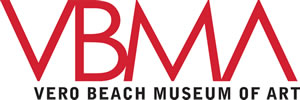



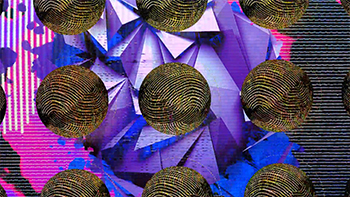


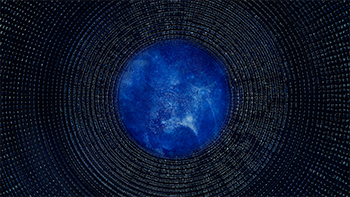


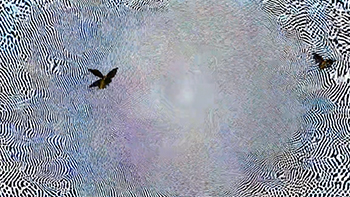
![Faux-Ecologies-+-Augmented-Visions-of-the-Nature-verse_-by-[dNASAb]_Web Faux-Ecologies-+-Augmented-Visions-of-the-Nature-verse_-by-[dNASAb]_Web](https://www.vbmuseum.org/wp-content/uploads/Faux-Ecologies-Augmented-Visions-of-the-Nature-verse_-by-dNASAb_Web.jpg)



